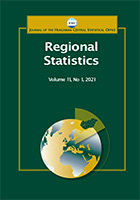Performance of enterprises in cultural and creative industries in large Hungarian cities between 2008 and 2018
Performance of enterprises in cultural and creative industries in large Hungarian cities between 2008 and 2018
Author(s): Petra Kinga Kézai, János RechnitzerSubject(s): Social Sciences, Economy, Geography, Regional studies
Published by: Központi Statisztikai Hivatal
Keywords: cultural and creative economy; urban research; urban development
Summary/Abstract: Unquestionably, the creative economy’s weight and importance in nation-states’ economies are increasing. This study examines the performance of partnerships belonging to creative industrial branches in Hungary between 2008 and 2018. Research questions are as follows: What economic potential does the creative economy represent in Hungary, particularly in certain large cities? What tendencies exist regarding temporal changes? What are the professional branches in cities that defy the creative economy, and how has their performance changed during the period examined in this study? This analysis deals with partnerships in the creative economy in Budapest and eight Hungarian cities with a population greater than 100,000. Dun & Bradstreet Hungary, Ltd., provided the database used as the basis for the statistical analysis. The data of companies operating on the last day of the given year were collected based on valid Hungarian activity classification (TEÁOR’08) codes and according to the indicated registered office, thus guaranteeing full national coverage. Regarding headcount data, only reports for the entire calendar year were included in the study, based on the statistical headcount for the given year. Within the study’s 11-year reach, research has shown that there were no significant territorial changes in the creative economy and that Budapest still dominates the landscape, with the other eight cities playing minor roles (11%–12%). During the study period, all the cities had individual development paths.
Journal: Regional Statistics
- Issue Year: 13/2023
- Issue No: 01
- Page Range: 167-198
- Page Count: 32
- Language: English

